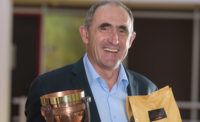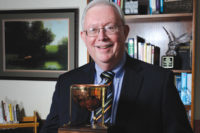‘Doing Our Best To Be The Best’: An inside look at 2015 European Candy Kettle Club Award recipient Jean-Luc Grisot of Valrhona
How does one improve upon a storied chocolate company specifically created for pastry chefs without being a pastry chef? For Jean-Luc Grisot, the answer was pretty simple: Manage with a human touch.

Jean-Luc Grisot photo by Jean Delmarty, other photos by Pauline Le Goff, Laurent Vu and Jerome Bryon.

In the company’s main manufacturing complex, which encompasses 150,000 sq. ft., seven “globeshaped” 200-kilo roasters process beans from 60 difference sources. All beans are roasted by origin, with roasting times varying between a half hour to an hour, and temperatures fluctuating between 120° and 150° C.

Once roasted, the beans are fed into a winnower and then deposited into 60 kilo-bags where they are segregated and staged.

Depending upon the recipe, an employee will either blend beans from different origins or simply use single origin beans before depositing them into a grated hopper opening, which feeds one of two grinders.

After grinding, the cocoa paste heads toward a prefiner, which reduces the paste into flakes ranging in size between 70 to 100 microns. The flakes are then conveyed to one of four five-roll refiners where the flakes are further reduced in size to 14 microns.

Conching involves a two-stage process. First, the flakes undergo dry conching, whereby the heat generated by the mixing blades turns them into liquid; then the liquid conching process begins, which achieves homogenization of previously added ingredients such as cocoa butter, vanilla, sugar, milk powder and lecithin. Conching times vary between 24 to 72 hours, again, depending upon the recipe.

More than 100,000 visitors "experience" and learn about chocolate annually in Valrhona's Cité du Chocolat.

Valrhona's Cité du Chocolat is a permanent interactive exhibit that provides 15 tasting moments in a fun, even frenetic way


Valrhona Chocolate in bars.

Holding tanks feed one of two moulding lines, which produce chocolate in bars or "fèves," the French word for cocoa beans.

The fèves resemble dried cocoa beans with an indent, the indent facilitating even melting of the beans prior to use by a pastry chef or chocolatier.












How does one improve upon a storied chocolate company specifically created for pastry chefs without being a pastry chef? For Jean-Luc Grisot, the answer was pretty simple: Manage with a human touch. Indeed, when he joined Tain l’Hermitage, France-based Valrhona in 2001 as its managing director, Grisot quickly recognized that there was plenty of passion geared toward producing the best possible chocolate.
To harness that passion in a manner that would prove productive for both the company and employees, he believed it was important to add a “humanistic” approach to operations. As he points out, “the success of Valrhona stems from the success of its employees.”
As a result, all of the company’s projects are shared with its employees. Acknowledging that it takes time to explain all the strategies and initiatives, Grisot says “it’s impossible to obtain results without a humanistic approach.”
The managing director points to the company’s double-digit growth during the past four years, punctuated by strong profits each of those years, as evidence.
“That’s the reason why we’re not financially oriented,” he explains. “Our success is a result of this humanistic approach. We provide an environment where people have the freedom to work, to share in a project. Consequently, when we let employees invest themselves into a project and the company, the results are very good.”
He cites the company’s introduction of Dulcey, the company’s blond-colored chocolate, several years ago as a classic example of employee involvement and persistence. Dulcey, which was introduced in 2013, represents more than eight years of research and testing by company’s R&D department as well as its L’Ecole Valrhona school system.
As the story goes, in 2005 Frederic Bau, the company’s executive pastry chef, was demonstrating a recipe for visiting professionals at the company’s L'Ecole Valrhona in Tain L'Hermitage. Upon finishing, he forgot about a white chocolate that was warming in a water bath. Only after returning to the kitchen 10 hours later did he discover that he had forgotten about the white chocolate.
In examining the white chocolate, Bau found that it had turned into a blond color and smelled of freshly baked shortbread. Upon tasting the white chocolate, the experience matched the aroma: a creamy texture with a buttery yet not-too-sweet note.
The next day Bau was able to recreate the chocolate. Thrilled, he shared the news with the team of professionals at the school and in R&D. Under Christophe Devaux’s lead, the group went to work on making this new chocolate commercially available. The process, however, proved more elusive than expected. Finally, in 2013 — after years of testing, refining and retesting — the company launched Dulcey, the world’s first all-natural, blond-colored chocolate. It proved to be an immediate success.
It’s not every company that allows its R&D group the freedom to focus on such a long-term project. But then it’s not every company that requires its executives to attend a Leadership Academy, whereby the emphasis is on learning how to listen. The eight-day course is designed to not only improve listening skills, but explores the best way to exploit emotions and one’s “fire in the belly,” or gut instincts.
No wonder Valrhona ranked 15th out of all French companies by the Great Place to Work organization in 2015. And the greatest barometer of such a ranking?
“The first sign of that is you see people smiling here,” says Grisot. “They are proud of the work they’re doing in Valrhona.”
And that work begins in the cocoa fields and plantations throughout the world, from 18 different countries. With four people dedicated to meeting and working with farmers, Valrhona’s connection to the crop is a close and personal one.
“We have direct relationships with the planters,” Grisot points out. “We know them. And everywhere we can, we are helping the planters' communities. First, by securing long-term agreements with the farmers, buying their entire crops. Then, be it building new schools or providing a filter for clean water, or whatever the community needs, we’re involved.”
As a small player amongst the multinationals, “We’re doing our part,” he adds. “There’s no ‘green washing’ at Valrhona.” Last year’s community projects totaled 17 in eight countries.
The company also owns and operates three of its own cocoa plantations, which are in the Dominican Republic, Venezuela and Madagascar.
“These are true assets,” Grisot emphasizes. “It’s not a question of supply; rather, it’s a question of knowledge.”
By being a planter, the company can assess first-hand which agricultural techniques and husbandry practices work best. Moreover, those best practices can be shared with and passed onto other farmers who supply Valrhona with cocoa beans. Naturally, as one would expect, the emphasis always revolves around improving the quality of the bean.
As such, here too, Valrhona has made a breakthrough, having successfully implemented a double-fermentation process using local fruits to infuse flavor into the cocoa bean. Ten years in development, the company introduced its first varieties last year in September: Itakuja 55%, a Brazilian couverture fermented with passionfruit and Manaka 62%, a Madagascan couverture fermented with oranges.
The process involves pouring juice from locally grown fruits during the second stage of fermentation, allowing the fruit sugars to ferment with the cocoa. Although more expensive than regular couvertures, the two fruit-infused couvertures have already garnered rave reviews from top-end pastry chefs and chocolatiers.
Another humanistic touch that Grisot has added also involves the plantations. Once a year, a 50-person group — divided up equally between customers and employees — visits one of the cocoa plantations that the company currently works with.
“It gives sense to our purpose,” Grisot explains. “Both customers and employees can see for themselves what we are doing to help the community. The first impressions are incredible, of course. By the end of the week, we truly have advocates for the Valrhona way.”
The Valrhona way embodies not only involvement with its suppliers, but also inspiration by and for its customers, primarily pastry chefs and chocolatiers. That involvement begins with the schools, the L’Ecole Valrhona.
Started more than 25 years ago in Tain l’Hermitage, the goal hasn’t changed, merely the scope. Since 1989, Valrhona has worked with more than 10,000 artisans and chefs, focusing on optimizing their skills and talents. Today, the company operates four schools (Tain l’Hermitage, Tokyo, Paris-Versailles and Brooklyn), and employs 25 pastry chefs.
“It’s not just about providing training; rather it’s about providing inspiration, about using new ingredients, exposing them to new ideas, targeting new trends,” says Grisot. “For example, we introduced yuzu [Japanese citrus] for the first time to many professionals.”
Pioneering, or being in the forefront, is another Valrhona characteristic, a trait encouraged by Grisot’s humanistic philosophy. Since 1987, when Valrhona held its first Night of Chocolate for the public, the company has consistently sought to inform the public about cocoa and chocolate, not merely instructing but engaging chocophiles and consumers alike to see, touch, listen and taste.
That endeavor was put on permanent display when the company opened its Cité du Chocolat in Tain l’Hermitage in 2013. This interactive exhibit — calling it a museum doesn’t do it justice — provides 15 tasting moments in a fun, even frenetic way, be it identifying smells, searching for aromas or playing touching and listening games to recognize chocolate’s textures. Visitors can also go travelling with an interactive planisphere to discover where Valrhona sources its beans as well as reproduce chefs’ skills, such as writing in chocolate, on a tactile tablet.
No surprise then that La Cité du Chocolat annually has 100,000 visitors. In fact, Grisot says the company has plans to add a second level to the exhibit next year.
The company also looks to expand its production capabilities as demand for its high-end products grow. Typically, capital expenditures range between 8 to 10 million euros annually. In 2016, the company looks to build new offices. Long-term goals involve adding more production space.
At the same time, the company remains committed to staying true to its artisanal nature, using a combination of historic roasters and winnowers with modern tempering, moulding and packaging equipment.
In the company’s main manufacturing complex, which encompasses 150,000 sq. ft., seven “globe-shaped” 200-kilo roasters process beans from 60 difference sources. All beans are roasted by origin, with roasting times varying between a half hour to an hour, and temperatures fluctuating between 120° and 150° C.
Once roasted, the beans are fed into a winnower and then deposited into 60 kilo-bags where they are segregated and staged.
Depending upon the recipe, an employee will either blend beans from different origins or simply use single origin beans before depositing them into a grated hopper opening, which feeds one of two grinders.
After grinding, the cocoa paste heads toward a prefiner, which reduces the paste into flakes ranging in size between 70 to 100 microns. The flakes are then conveyed to one of four five-roll refiners where the flakes are further reduced in size to 14 microns.
From there, the two-stage process of conching begins. First, the flakes undergo dry conching, whereby the heat generated by the mixing blades turns them into liquid; then the liquid conching process begins, which achieves homogenization of previously added ingredients such as cocoa butter, vanilla, sugar, milk powder and lecithin. Conching times vary between 24 to 72 hours, again, depending upon the recipe.
The chocolate is then pumped into any one of 10 holding tanks, where it will be pumped out to one of two moulding lines as required. Depending upon the customer, the chocolate can be moulded into bars or "fèves," the French word for cocoa beans. The fèves resemble dried cocoa beans with an indent, the indent facilitating even melting of the beans prior to use by a pastry chef or chocolatier.
Valrhona also produces a range of bonbons and pralines at its original factory, which is located next to the Cite du Chocolat. Two enrobing lines coat a variety of centers to create a broad range of finished confections. Decorators put the finishing touches on those pieces requiring an artistic finish.
As expected, given its reputation, the company maintains an extensive quality control and quality assurance regimen. In addition, it trains and uses 200 employees on seven tasting panels as its guardians of "Goût" or Taste.
There’s also a L’Ecole Valrhona du Goût or Valrhona School of Taste. Again, as Grisot points out, it’s about Valrhona doing “its part” to educate all pastry chefs and chocolatiers about the sensory experience. It’s about offering tools to professionals to help them with improving their craft and fine-tuning their talents on a foundation based on 15 years of sensory expertise.
As Grisot emphasizes, there are many companies that sell chocolate. “Our goal is to work for and with pastry chefs and chocolatiers. That’s a major difference. We focus on doing our best to be the best.”
At-a-Glance: Valrhona
Headquarters: Tain l’Hermitage, France
Employees: 700
Products: Couvertures, gran crus, cocoa powder, chocolate bars, chocolate confections
Founded: 1922
See also: Photos from the European Candy Kettle Club Reception
See also: ‘The Valrhona way’: What makes Jean-Luc Grisot's leadership so special?
Looking for a reprint of this article?
From high-res PDFs to custom plaques, order your copy today!





















